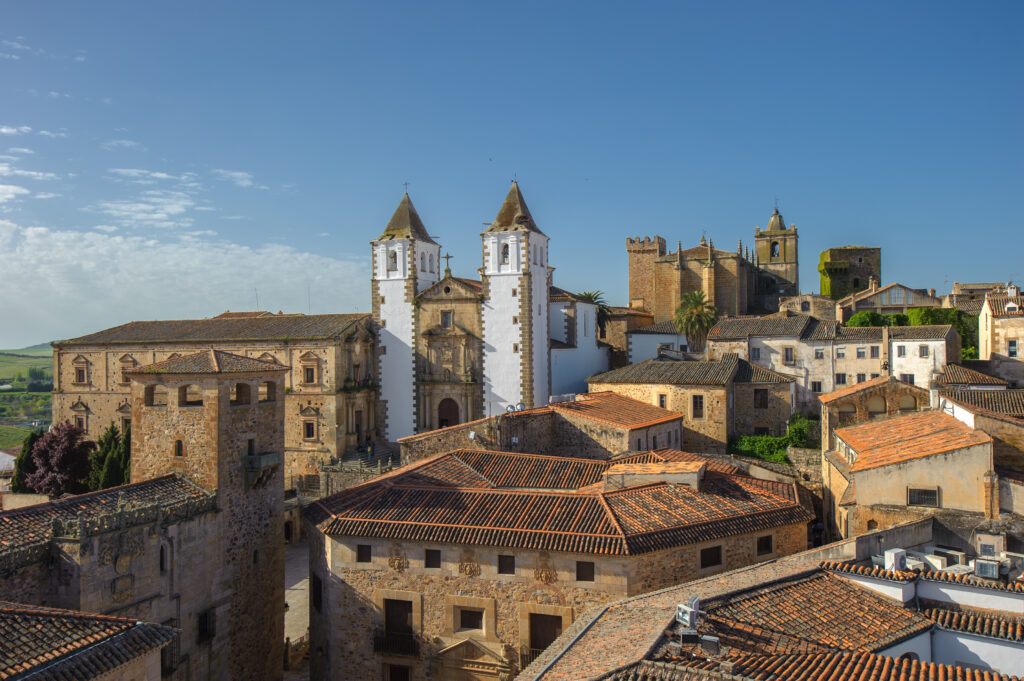

At a time when global competence and cultural literacy are no longer optional in education, Delaware has taken a bold step forward. Through a visionary partnership between the Delaware Department of Education and the University of Delaware, the Delaware Teacher’s Program in Spain—an innovative study abroad initiative—is reshaping how Spanish language educators are trained and supported. The program provides K–12 teachers with a powerful combination of immersive experiences, academic coursework, and professional collaboration, all situated in the vibrant cultural landscape of Cáceres, Spain.
Now entering its third year, the program was designed to respond directly to the needs identified by Delaware educators: the desire for sustained language immersion, more robust content specific graduate offerings, and hands-on training that connects language instruction with contemporary cultural realities. The emergence of these needs was influenced in part by Delaware’s adoption of the World-Readiness Standards for Learning Languages (Delaware Department of Education, 2016) and by the authors’ growing awareness of the wide range of preparation routes—both conventional and unconventional—that individuals follow to become classroom educators.
These needs are not unique to Delaware. Across the country, world language teachers are seeking opportunities to maintain and advance their proficiency, stay current with pedagogical trends, and deepen their intercultural understanding— all of which are essential in the increasingly diverse classrooms they serve (Ermeling, 2012; Haley et al., 2013).
The two-week summer program in Cáceres offers teachers an extraordinary opportunity to live with local host families—an immersive experience that deepens language acquisition and cultural awareness beyond the classroom walls. These homestays foster authentic daily interactions, from shared meals and personal conversations to navigating everyday routines, giving teachers insight into family life, regional customs, and the subtle rhythms of local speech.
When they are not exploring Spanish culture in their family stays, participants attend daily academic seminars at the Universidad de Extremadura, led by an interdisciplinary team of faculty from the University of Delaware, the Universidad de Extremadura, and local institutions. One core course, Methods of Teaching Spanish Culture, prepares educators to design culturally relevant curricula using authentic materials. A new course, Hispanic Children’s Literature, will explore the integration of literacy instruction with rich cultural content—a particularly timely focus as dual language and bilingual programs continue to expand nationwide.
The cultural programming curated around these courses brings the curriculum to life. Teachers visit Cáceres’s renowned museums—including the Museo Provincial and the Helga de Alvear Contemporary Art Center—where they reflect on how visual culture, historical narratives, and material heritage can be leveraged as pedagogical tools. Students also attend poetry recitals and theatrical events that immerse them in Spain’s literary traditions while offering opportunities to think creatively about public arts projects and their integration into their own classrooms. One evening event, featuring a traditional music masterclass and concert by Cáceres-based artist Luis Regidor, sparked discussion among participants about incorporating music as a vehicle for language learning and cultural empathy.
Perhaps the most transformative experiences come through the local school visits and professional dialogues with Spanish educators. Participants observe classes at local schools and meet with teachers, administrators, and education students to exchange perspectives on teaching practices. These encounters offer candid insights into Spanish education models while forging meaningful connections between professionals across borders. The experiences have been so rewarding that several Delaware teachers have maintained contact with their Spanish counterparts beyond the program, opening possibilities for collaborative classroom projects, virtual exchanges, and long-term pedagogical partnerships.
Central to the program’s success is the leadership of Professor Antonia Paín Arias, senior lecturer at the Universidad de Extremadura’s School of Education. As the program’s on-site coordinator, Professor Paín plays a vital role in bridging the logistical, academic, and cultural dimensions of the experience. Her expertise in language education and international teacher training has shaped the program’s structure from its inception. She not only coordinates local faculty and activities but also designs many of the sessions, with an eye toward methodological relevance and pedagogical application. Participants consistently highlight her role as essential to creating a cohesive and welcoming academic environment in Cáceres. Through her leadership, the collaboration between the University of Delaware and UEx has flourished into a model of international partnership in educator development and training.
Equally notable is the program’s commitment to access and equity. Thanks to joint funding from the state and university, the total cost to teachers averages around $450, which covers the cost of nearly all program amenities including graduate credit. This inclusivity has allowed a diverse cohort of educators to participate, including heritage speakers, first-generation college graduates, and teachers from underrepresented districts. Beyond the cultural and linguistic immersion, the program is also academically rigorous. Participants earn three to six graduate credits through the University of Delaware, and the program now serves as a cornerstone for a broader credentialing pathway. In 2025, the university will launch a new graduate certificate in educational leadership and intercultural competence development in Spanish—the first program of its kind in the state.
The certificate is designed for educators who seek to lead within their schools, districts, and communities, especially those working in bilingual, dual language, and ESL contexts. It comprises 15 graduate credits and can be completed through a flexible mix of in-person, online, and study abroad offerings. Courses range from advanced grammar and oral proficiency to modules on curriculum design, inclusive leadership, and intercultural communication. The goal is to create a professional development model that is both intellectually robust and practically applicable to the realities of today’s classrooms. A cornerstone of the new certificate is the program abroad in Cáceres, where student experience and academic achievement figure directly into the certificate requirements.
Feedback from program participants highlights the profound personal and professional transformations that occur. One teacher reflected, “It was the most meaningful professional development of my career. I not only improved my Spanish—I found my voice again as a cultural educator.” Another, who teaches in a Delaware dual language immersion school, shared that the program “reconnected me with the joy of learning. I saw how culture could be taught not just through facts but through lived experience, through music, food, community—things that resonate with our students.”
For participants, the experience reshapes their pedagogy. Lesson plans evolve to include authentic materials gathered during the program—local newspapers, menus, oral histories, children’s books, and traditional music. Students back home benefit from a richer, more contextualized learning environment, one that brings Spanish-speaking cultures to life in the classroom. Some teachers have even collaborated post-program to develop interdisciplinary units that link language instruction to art, history, and social studies, building cross-curricular connections that strengthen student engagement. Perhaps most important, however, is the renewed sense of purpose and high energy that teachers take back to their students.
In terms of measurable outcomes, the program employs multiple tools to assess impact. Participants complete the Versant test of spoken Spanish pre- and post-program to gauge oral proficiency. While some results were affected by technical inconsistencies, nearly half of participants demonstrated gains. More compelling are the results from an intercultural competence self-assessment adapted from leading scholars in the field (Bennett, 2009; Deardorff, 2006; Deardorff, 2011). Participants reported significant growth in self-awareness, cultural perspective, and collaborative problem solving—key skills in creating inclusive learning environments for multilingual learners.
The success of this program invites reflection on broader national implications. While many states offer professional development for language teachers, few programs integrate international experience with graduate-level coursework in such a structured and affordable way. Delaware’s model stands out not only for its academic rigor and accessibility but also for its intentional focus on leadership, literacy, and equity.
In states like Utah, North Carolina, and Oregon, where dual language immersion programs are well established, there is increasing recognition of the need to invest in teacher capacity. Delaware’s initiative complements these efforts by adding a global dimension—one that affirms the value of cultural immersion not just for students but for the educators who guide them. It also responds to ongoing concerns about teacher retention. Research shows that meaningful professional development is one of the strongest predictors of teacher satisfaction and longevity (Buczynski and Hansen, 2010; Darling-Hammond et al., 2017). Programs like this, which offer intellectual renewal, cultural enrichment, and a sense of community, have the potential to strengthen the profession from within.


As other states consider how to support their growing multilingual student populations, the Delaware Teacher’s Program in Spain offers a replicable, scalable model. It demonstrates that strategic investments in teacher learning—especially when tied to global experiences—can yield returns far beyond the classroom. These include stronger student outcomes, more inclusive school cultures, and an education workforce better prepared to meet the demands of a global society. While not explicitly the goal of the program, a pleasant byproduct also worth mentioning is how participants feel renewed inspiration to learn and teach, reigniting a passion that will positively impact their students.
Looking ahead, we plan to expand the program’s reach. Future editions will include enhanced literacy modules, virtual exchanges with partner schools in Spain, and additional certificate pathways. There is also interest in opening the program to teachers of other world languages, including French and Chinese, reflecting Delaware’s broader vision for multilingualism as a core component of college and career readiness. Most importantly, we envision the graduate certificate in educational leadership and intercultural competence development in Spanish not only as a resource for educators in Delaware but as a national and international model for preparing language educators to lead in linguistically and culturally diverse classrooms. With its flexible structure, emphasis on intercultural training, and international immersion opportunities, the certificate sets a new standard for meaningful, globally minded professional development.
At its heart, the Delaware Teacher’s Program in Spain affirms a simple truth: that preparing students to thrive in a diverse and interconnected world begins with empowering the educators who serve them. Through rigorous coursework, cultural immersion, and a commitment to equity, the program equips teachers not only to speak Spanish fluently but also to teach it with cultural depth, ethical purpose, and renewed imagination.
References
Bennett, J. M. (2009). “Transformative Training: Designing programs for cultural learning.” In M. A. Moodian (Ed.), Contemporary Leadership and Intercultural Competence: Exploring the Cross-Cultural Dynamics Within Organizations (pp. 95 110). SAGE.
Buczynski, S., and Hansen, C. B. (2010). “Impact of Professional Development on Teacher Practice: Uncovering connections.” Teaching and Teacher Education, 26(3), 606–614.
Darling-Hammond, L., Hyler, M. E., and Gardner, M. (2017). Effective Teacher Professional Development. Learning Policy Institute.
Deardorff, D. K. (2006). “Identification and Assessment of Intercultural Competence as a Student Outcome of Internationalization.” Journal of Studies in International Education, 10(3), 241–266.
Deardorff, D. K. (2011). “Assessing Intercultural Competence.” New Directions for Institutional Research, 2011(149), 65–79.
Delaware Department of Education. (2016). World-Readiness Standards for Learning Languages. https://education.delaware.gov/legacy/wp-content/uploads/sites/4/2024/06/delaware_world-readiness_standards_for_learning_languages_040816.pdf
Ermeling, B. A. (2012). “Improving Teaching Through Continuous Learning: The inquiry process John Wooden used to become coach of the century.” Quest, 64(3), 197–208.
Haley, M. H., Steeley, S. L., and Salahshoor, M. (2013). “Connecting 21st-Century Skills and World Language Practices: A case study with teachers of critical need languages.” Theory and Practice in Language Studies, 3(6), 865–876. https://doi.org/10.4304/tpls.3.6.865-876
Dr. Basia Musik Moltchanov is associate professor of Spanish and world language pedagogy at the University of Delaware. She co-directs the Delaware Teacher’s Program in Spain and specializes in second language acquisition, teacher education, and curriculum development for world language educators.
Dr. Julia Domínguez is professor of Spanish at the University of Delaware, where she co directs the Delaware Teacher’s Program in Spain and teaches courses on intercultural competence, culture in context, and literature.


